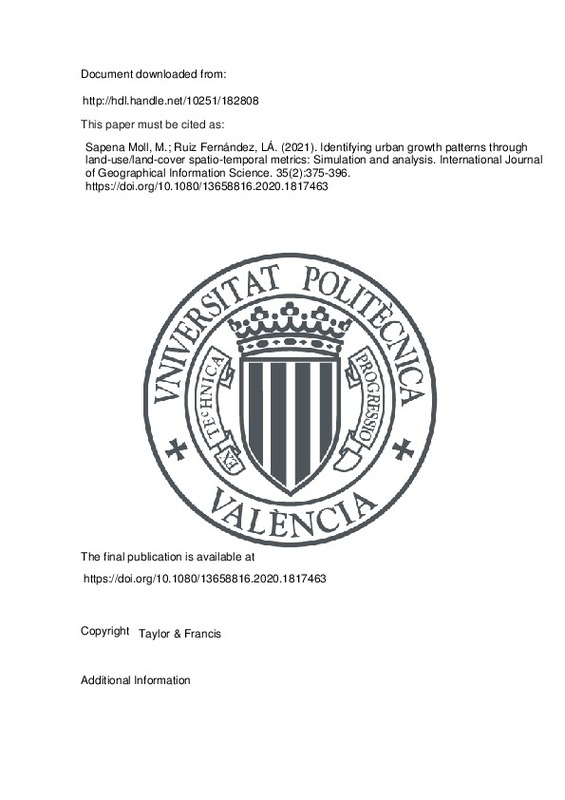JavaScript is disabled for your browser. Some features of this site may not work without it.
Buscar en RiuNet
Listar
Mi cuenta
Estadísticas
Ayuda RiuNet
Admin. UPV
Identifying urban growth patterns through land-use/land-cover spatio-temporal metrics: Simulation and analysis
Mostrar el registro sencillo del ítem
Ficheros en el ítem
| dc.contributor.author | Sapena Moll, Marta
|
es_ES |
| dc.contributor.author | Ruiz Fernández, Luis Ángel
|
es_ES |
| dc.date.accessioned | 2022-05-23T18:04:02Z | |
| dc.date.available | 2022-05-23T18:04:02Z | |
| dc.date.issued | 2021-02-01 | es_ES |
| dc.identifier.issn | 1365-8816 | es_ES |
| dc.identifier.uri | http://hdl.handle.net/10251/182808 | |
| dc.description.abstract | [EN] The spatial pattern of urban growth determines how the physical, socio-economic and environmental characteristics of urban areas change over time. Monitoring urban areas for early identification of spatial patterns facilitates assuring their sustainable growth. In this paper, we assess the use of spatio-temporal metrics from land-use/land-cover (LULC) maps to identify growth patterns. We applied LULC change models to simulate different scenarios of urban growth spatial patterns (i.e., expansion, compact, dispersed, road-based and leapfrog) on various baseline urban forms (i.e., monocentric, polycentric, sprawl and linear). Then, we computed the spatio-temporal metrics for the simulated scenarios, selected the most informative metrics by applying discriminant analysis and classified the growth patterns using clustering methods. Two metrics, Weighted mean expansion and Weighted Euclidean distance, which account for the densification, compactness and concentration of urban growth, were the most efficient for classifying the five growth patterns, despite the influence of the baseline urban form. These metrics have the potential to identify growth patterns for monitoring and evaluating the management of developing urban areas. | es_ES |
| dc.description.sponsorship | This work was supported by the the Spanish Ministerio de Economia y Competitividad and FEDER [CGL2016-80705-R]. | es_ES |
| dc.language | Inglés | es_ES |
| dc.publisher | Taylor & Francis | es_ES |
| dc.relation.ispartof | International Journal of Geographical Information Science | es_ES |
| dc.rights | Reconocimiento - No comercial (by-nc) | es_ES |
| dc.subject | Spatio-temporal metrics | es_ES |
| dc.subject | Urban form | es_ES |
| dc.subject | Urban simulation | es_ES |
| dc.subject | Land-use/land-cover change model | es_ES |
| dc.subject | Growth pattern | es_ES |
| dc.subject.classification | INGENIERIA CARTOGRAFICA, GEODESIA Y FOTOGRAMETRIA | es_ES |
| dc.title | Identifying urban growth patterns through land-use/land-cover spatio-temporal metrics: Simulation and analysis | es_ES |
| dc.type | Artículo | es_ES |
| dc.identifier.doi | 10.1080/13658816.2020.1817463 | es_ES |
| dc.relation.projectID | info:eu-repo/grantAgreement/AGENCIA ESTATAL DE INVESTIGACION//CGL2016-80705-R//ANALISIS Y VALIDACION DE PARAMETROS DE ESTRUCTURA FORESTAL DERIVADOS DE LIDAR Y OTRAS TECNICAS EMERGENTES Y SU INCIDENCIA EN LA MODELIZACION DEL POTENCIAL COMBUSTIBLE/ | es_ES |
| dc.rights.accessRights | Abierto | es_ES |
| dc.contributor.affiliation | Universitat Politècnica de València. Departamento de Ingeniería Cartográfica Geodesia y Fotogrametría - Departament d'Enginyeria Cartogràfica, Geodèsia i Fotogrametria | es_ES |
| dc.description.bibliographicCitation | Sapena Moll, M.; Ruiz Fernández, LÁ. (2021). Identifying urban growth patterns through land-use/land-cover spatio-temporal metrics: Simulation and analysis. International Journal of Geographical Information Science. 35(2):375-396. https://doi.org/10.1080/13658816.2020.1817463 | es_ES |
| dc.description.accrualMethod | S | es_ES |
| dc.relation.publisherversion | https://doi.org/10.1080/13658816.2020.1817463 | es_ES |
| dc.description.upvformatpinicio | 375 | es_ES |
| dc.description.upvformatpfin | 396 | es_ES |
| dc.type.version | info:eu-repo/semantics/publishedVersion | es_ES |
| dc.description.volume | 35 | es_ES |
| dc.description.issue | 2 | es_ES |
| dc.relation.pasarela | S\417304 | es_ES |
| dc.contributor.funder | AGENCIA ESTATAL DE INVESTIGACION | es_ES |
| dc.subject.ods | 11.- Conseguir que las ciudades y los asentamientos humanos sean inclusivos, seguros, resilientes y sostenibles | es_ES |







![[Cerrado]](/themes/UPV/images/candado.png)

